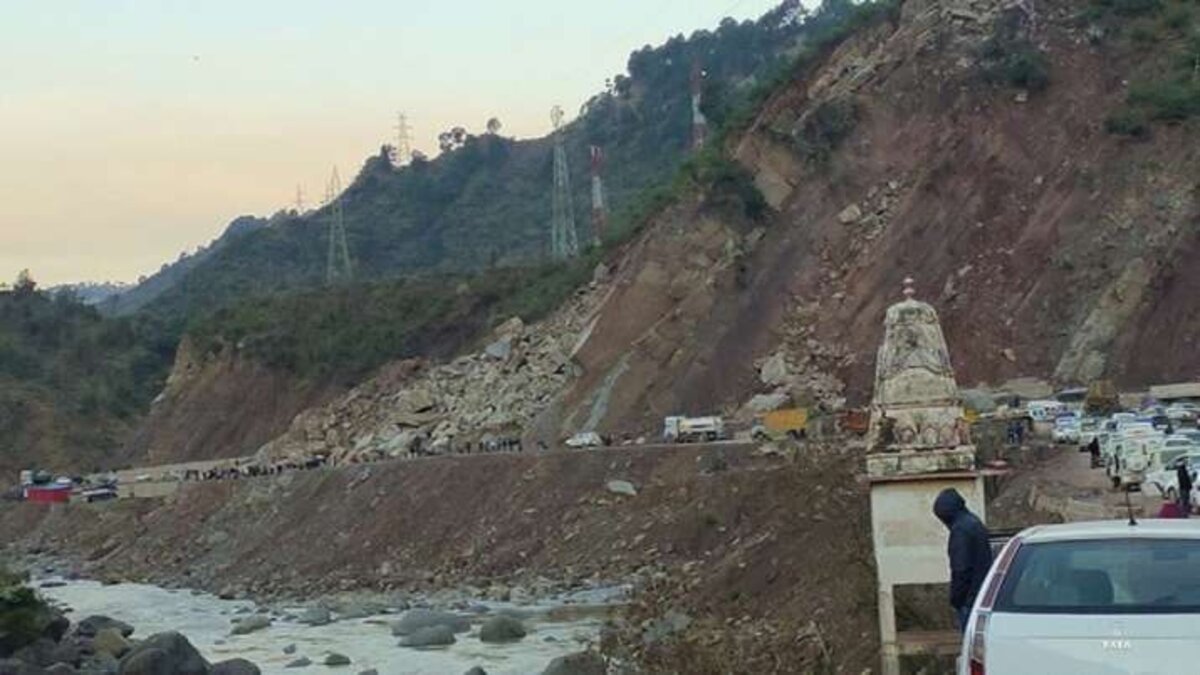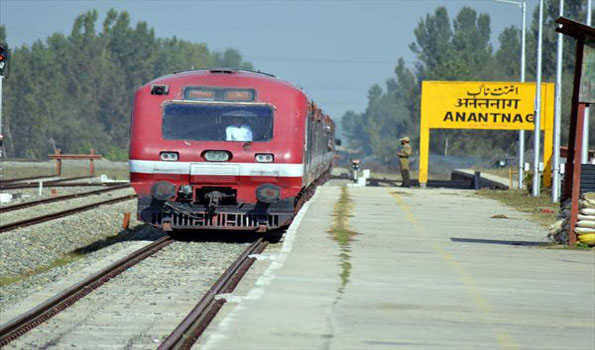Night of Chaos: Landslide Strikes Narsoo–Samroli, Trapping Dozens and Damaging Properties
By: Javid Amin | 12 October 2025
It was around 11:45 p.m. on October 12, 2025, when residents of Narsoo village, near Samroli in Udhampur district, were jolted awake by a thunderous roar echoing through the night. Within seconds, a massive chunk of hillside collapsed onto the Jammu–Srinagar National Highway (NH-44), one of India’s most strategic and economically vital road corridors.
The avalanche of mud, rocks, and debris tore through several roadside structures — including a small hotel and adjoining houses — leaving behind a trail of destruction and chaos. The impact was so severe that portions of the retaining wall and the protective barriers along the slope crumbled instantly, cutting off vehicular movement between Nashri and Banihal, a stretch already notorious for frequent landslides.
Live visuals shared by travelers showed terrifying scenes — boulders tumbling down the mountain, plumes of dust enveloping vehicles, and stranded commuters running for safety under the dim glow of headlights.
“It felt like an earthquake. We heard a loud rumble, then saw a wall of mud and rocks engulf the road. A nearby hotel collapsed within seconds,”
— Abdul Majid, a truck driver who narrowly escaped the slide.
Strategic Lifeline Disrupted — NH-44 Comes to a Standstill
The Jammu–Srinagar National Highway (NH-44) is not just any road. It is the arterial lifeline of the Union Territory of Jammu & Kashmir, carrying essential supplies — fuel, food, and medicine — to the landlocked Kashmir Valley. Every closure leads to ripple effects:
-
soaring prices of vegetables and commodities in Srinagar and Baramulla,
-
fuel shortages,
-
and logistical challenges for tourists and local businesses alike.
By early morning on October 13, hundreds of vehicles, including trucks loaded with perishable goods, remained stranded for miles along both sides of the affected stretch near Udhampur’s Narsoo–Samroli sector.
The Traffic Police Control Room in Ramban and Udhampur confirmed multiple blockages between Chenani, Nashri, and Samroli, making travel unsafe. Rescue teams from the National Highways Authority of India (NHAI), the District Administration, and the State Disaster Response Force (SDRF) were immediately mobilized.
Buildings Collapse: Hotel and Shops Destroyed
One of the worst-hit structures was a two-storey hotel complex situated perilously close to the hillside. Eyewitnesses reported that the building tilted and crumbled under the pressure of the landslide, with debris scattered across the carriageway. Fortunately, most occupants managed to escape moments before the collapse.
Udhampur Deputy Commissioner Saloni Rai (IAS) confirmed that no fatalities have been reported so far, though property damage is extensive.
Rescue workers continued combing through the rubble using excavators, loaders, and manual tools late into the morning.
“The landslide has caused significant damage to roadside infrastructure, but our priority is ensuring there is no loss of life. Traffic movement remains suspended as clearance work continues on war footing,”
— DC Udhampur, Saloni Rai.
Weather Turns Hostile — Rain, Snow, and Slush Complicate Operations
The landslide comes amid relentless rainfall and snowfall triggered by an active Western Disturbance that has been hovering over Jammu & Kashmir since October 4.
The India Meteorological Department (IMD) reported above-normal precipitation in the Pir Panjal and Greater Himalayan ranges, leading to waterlogging, snow accumulation, and soil destabilization.
⚠️ Key Weather-Affected Zones:
-
Sinthan Top & Peer Ki Gali: Over 1 foot of snow, road closed.
-
Gulmarg & Sonamarg: Fresh snowfall disrupting tourist flow.
-
Mughal Road (Rajouri–Poonch–Shopian): Closed due to slippery surfaces.
-
SSG Road (Srinagar–Sonamarg–Gumri): Blocked by snow at Zojila Pass.
The combination of continuous rainfall and snowmelt has saturated soil layers along the Jammu–Srinagar corridor, making slopes dangerously unstable. Experts from the Geological Survey of India (GSI) warn that repeated slope cuts and deforestation have made the area more prone to such events.
Geological Experts Warn of “Cumulative Instability”
Landslides are not new to NH-44, particularly in the Ramban–Banihal–Udhampur belt. However, the frequency and intensity of these incidents have increased dramatically in recent years.
Environmental scientists attribute this to unplanned slope cutting during highway expansion, coupled with inadequate drainage and erosion control.
“The Narsoo–Samroli stretch sits on fragile sedimentary rock. When heavy rainfall persists, the soil loses cohesion, triggering massive slope failures. Without bio-engineering and slope stabilization, such disasters will recur,”
— Dr. Neelesh Kaul, Geotechnical Expert, University of Jammu.
A recent study by the Central Road Research Institute (CRRI) identified more than 80 active landslide-prone zones along NH-44, with Udhampur and Ramban districts being the most critical.
Rescue and Relief on War Footing
Soon after the disaster, the Udhampur District Administration, assisted by the National Highway Authority of India (NHAI), launched a multi-agency rescue operation.
Heavy earthmovers were deployed from the Chenani base camp, and additional personnel from SDRF and Fire & Emergency Services were dispatched to Narsoo.
The District Police cordoned off the area to prevent civilians from approaching the unstable slope, while local volunteers helped evacuate stranded passengers to safer zones.
🔹 Emergency Helpline Numbers:
-
Jammu: 0191-2459048, 0191-2740550
-
Srinagar: 0194-2450022, 1800-180-7091
-
Ramban: 9419993745, 1800-180-7043
By 10 a.m. the next day, partial clearance began, though continuous shooting stones and minor mudslides forced repeated halts. Officials estimate it may take 24–36 hours to fully restore two-way traffic if the weather improves.
Ripple Effect: Supplies, Tourism, and Daily Life Disrupted
The Jammu–Srinagar highway blockade has far-reaching consequences beyond transport delays.
🛢️ Essential Commodities:
Truck convoys carrying petrol, LPG, fruits, and vegetables remain stranded. In Srinagar and Pulwama, fuel station queues have started to lengthen, and wholesale vegetable prices are already up by 15–20%.
🏨 Tourism Setback:
This comes at a time when Kashmir tourism is already under strain due to rising airfares and uncertain weather. Tour operators reported mass cancellations and postponements of Diwali travel packages.
“Tourists from Delhi and Mumbai who planned road trips have had to cancel. Even air routes are unreliable due to weather-related delays,”
— Sajjad Ahmad, JKL Travels.
📦 Logistics Chain Hit:
Goods bound for the Kashmir Valley are delayed at Udhampur, Ramban, and Qazigund, affecting markets in Anantnag and Srinagar.
BRO and NHAI Gear Up for Road Restoration
The Border Roads Organisation (BRO) and NHAI maintenance units have intensified clearance efforts using JCBs, dozers, and excavators. However, the unstable terrain poses a major challenge.
“We’re using controlled rock cutting and geotextile covers to stabilize slopes. Restoration will depend on weather clearance,”
— Engineer Rakesh Suri, NHAI Project Director, Udhampur.
Authorities are also considering temporary reroutes for stranded vehicles via Chenani–Sudhmahadev–Dudu Road, though that road too remains partially affected.
Recurring Crisis — The Need for Sustainable Highway Design
Experts have repeatedly urged the government to rethink the engineering and environmental model of the Jammu–Srinagar Highway. Despite over ₹10,000 crore spent on widening and tunneling projects, the route remains vulnerable due to geological fragility and poor maintenance.
Key Long-Term Recommendations:
-
Slope stabilization with vegetation and retaining walls
-
Drainage systems to prevent waterlogging along cut slopes
-
Early warning systems using geotechnical sensors
-
Strict regulation of roadside construction near slide zones
-
Periodic GSI assessments for high-risk patches
Unless implemented urgently, such incidents will continue to threaten lives and disrupt connectivity to Kashmir.
Human Stories Amid the Rubble
In the chaos, tales of survival and resilience emerge.
A family of five staying at the collapsed hotel survived because they had stepped out moments earlier for dinner. Truckers stranded for over 12 hours shared food with local residents offering tea and shelter.
“This road is our lifeline — but it’s also our nightmare,”
— Mohammad Shafi, truck driver from Anantnag.
IMD Forecast: More Trouble Ahead
According to the India Meteorological Department (IMD)’s regional office in Srinagar, the Western Disturbance affecting J&K is expected to persist till October 15, with chances of moderate-to-heavy rain in the plains and snowfall at higher reaches.
“The weather system is likely to weaken after October 15, but until then, landslide and flash flood risk remains high,”
— Dr. Mukhtar Ahmad, IMD Srinagar.
Authorities have urged citizens to avoid unnecessary travel, follow official advisories, and keep emergency kits ready in vulnerable districts like Udhampur, Ramban, and Reasi.
Bottom-Line: A Fragile Road in a Fragile Land
The Narsoo–Samroli landslide is yet another reminder of the fragility of mountain infrastructure in the Himalayas — a region where human ambition often clashes with nature’s unpredictable power.
While authorities rush to reopen the highway, the incident exposes the urgent need for climate-resilient planning, strict construction norms, and effective early-warning systems.
As the people of Jammu and Kashmir brace for another round of unpredictable weather, one message rings clear:
Until sustainable engineering meets natural harmony, the road to Kashmir will remain as vulnerable as the mountains it cuts through.



